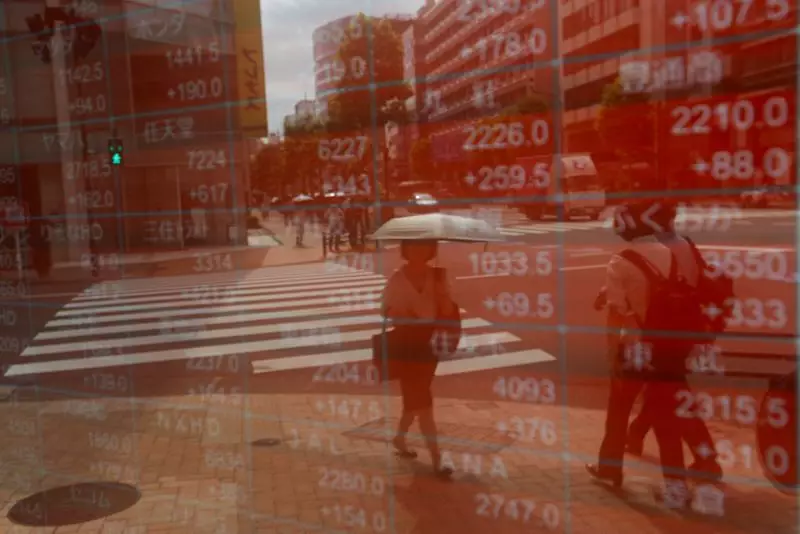The inauguration of Donald Trump as the 45th President of the United States has sent ripples through global financial markets, reflecting an environment of uncertainty and volatility. Investors remained on edge as headlines regarding potential trade policies and tariffs sparked an immediate reaction. Analyzing the intricate economic landscape that emerged on this day provides valuable insights into how Trump’s administration might shape market dynamics moving forward.
Markets greeted Trump’s presidency with a mix of optimism and trepidation, particularly given the backdrop of Trump’s previously stated plans for aggressive tariffs on a range of goods, especially from Mexico and Canada. On Tuesday, Asian markets experienced significant fluctuations as they reacted to the first comments from the newly sworn-in president. Notably, a brief sense of relief among investors, prompted by the absence of immediate tariff announcements in Trump’s inaugural speech, was quickly overshadowed when the president hinted at imposing a 25% tariff on goods from Mexico and Canada effective February 1. This announcement sent the Mexican peso plummeting by 1% against the dollar, while the Canadian dollar dropped to its lowest point in five years.
Such abrupt market movements highlight the sensitivity of global markets to policy shifts. When investors expected delays in tariff implementation, the sudden reality that tariffs could be placed almost immediately sent shockwaves through various asset classes. Charu Chanana, Saxo’s chief investment strategist, accurately noted that the markets celebrated prematurely, demonstrating how quickly perceptions can shift in response to policy announcements.
In the United States, stock futures initially climbed but experienced a notable retreat as realignment took hold. The Nasdaq futures fell by 0.08%, illustrating how the prospect of immediate tariffs impacted investor sentiment. In contrast, the S&P 500 experienced a more stagnant gain of just 0.07%. European markets reflected this volatility as well, with Euro Stoxx 50 futures dipping by 0.25%. The Japan’s Nikkei index mirrored this uncertainty, oscillating between slight gains and losses.
The anticipation surrounding Trump’s economic policy was palpable, with many investors projecting that heavy import tariffs would drive inflation, ultimately stimulating a heated U.S. economy. The resulting strength in the dollar would potentially weigh on bond prices, leading to increased yields. This view was supported by Khoon Goh, head of Asia research at ANZ, who argued that while the president hadn’t addressed tariffs on his first day, they remained a priority.
As huge market shifts unfolded, currencies responded accordingly. The dollar rebounded after earlier losses, distancing itself from a two-week low against major currencies. The euro declined by 0.3% to $1.0385, and the British pound fell by 0.32% to $1.2290. The U.S. Treasury market saw yields, which move inversely to bond prices, adjust significantly. The 10-year Treasury yield dropped by 6.7 basis points, demonstrating the resilience of bond markets amid looming tariff threats.
Meanwhile, investors kept a cautious eye on the implications of tariff discussions for international markets, particularly China. Trump’s threats regarding potential tariffs of up to 60% on Chinese imports cast a long shadow, but the lack of immediate action lulled market volatility momentarily. China’s major indices, including the CSI300 and the Shanghai Composite Index, reflected confusion among investors, slightly declining in response to the mixed signals emanating from U.S. policy discussions.
Beyond equities and currencies, commodities also felt the impact of Trump’s impending strategies. Oil prices slumped as Trump announced plans to maximize U.S. oil production, further entrenching the market in a tenuous situation. Brent crude futures hovered near their lowest levels for over a week, indicating market wariness surrounding potential increases in production capacities that threaten to saturate the already struggling market.
In the realm of cryptocurrencies, excitement around potential regulatory changes under Trump initially sparked a rally, with Bitcoin briefly surging to record highs. However, as uncertainties arose regarding the administration’s stance on cryptocurrency regulations, Bitcoin prices retracted, illustrating the sector’s inherent volatility.
Donald Trump’s ascent to the presidency has marked a new chapter for global markets steered by uncertainty and volatility. The initial days of his administration highlighted the profound impact of political statements and predictions on economic performance. Investors, analysts, and the general public must brace themselves for an unpredictable economic environment where trade policies could swiftly pivot between hope and alarm. As global markets navigate this complex landscape, the balance between optimism and caution will likely dictate financial performance in the months ahead.

